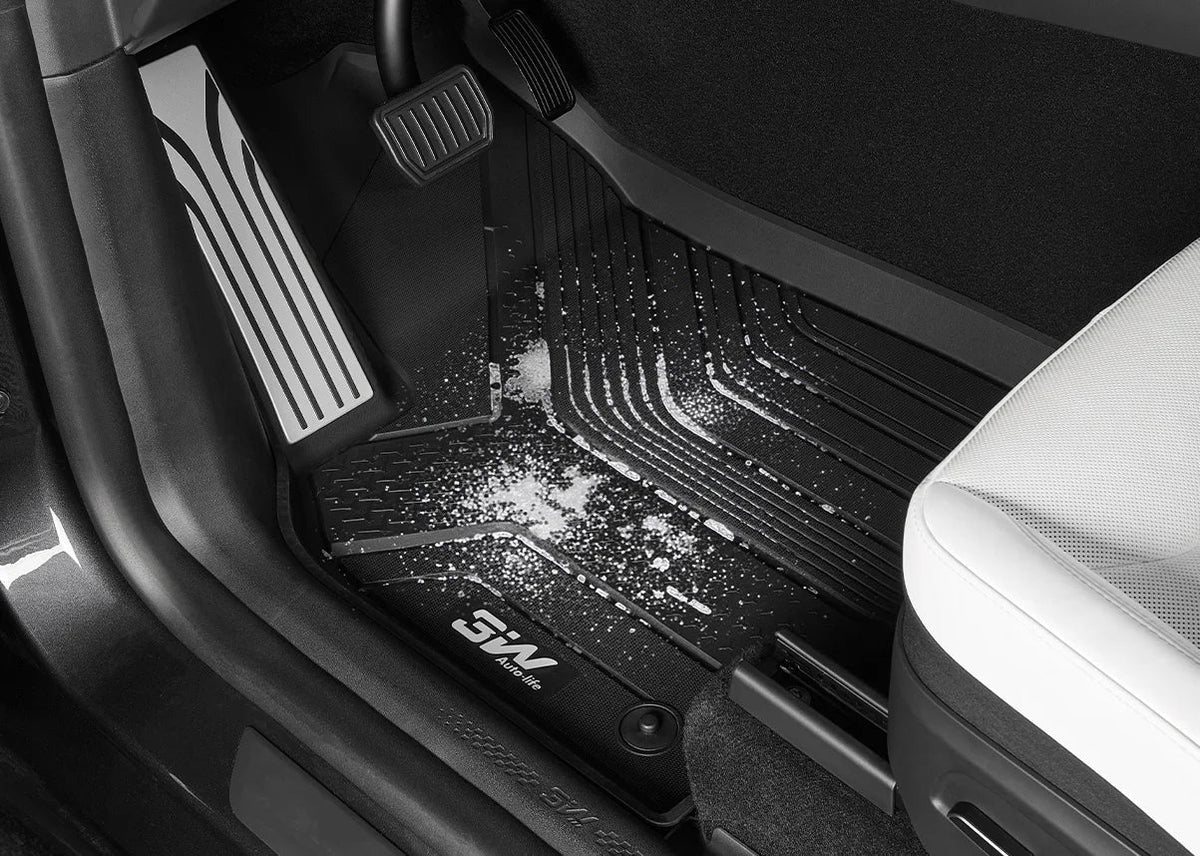

Winter roads may keep you safe, but the salt they leave behind can do the opposite for your car mats. Every year, cities in North America spreadmillions of tons of road salt to fight ice. This salt sticks to shoes, gets carried into cars, and leaves behind white marks that are hard to miss.
These stains do more than look bad. Salt can dry out carpet fibers and leave rubber mats stiff. If left for long, it may also cause odor and shorten the life of the mat. That is why many drivers look for simple steps on how to get salt stains out of car mats before damage sets in.
In this guide, we will explain the causes and cleaning tips.
Table of contents
What Causes Salt Stains on Car Mats
It is better to know how these stains show up in the first place.
In winter, the road crews spread salt to melt snow and ice, which lowers the freezing point of water. It makes roads less slippery for drivers.
The problem begins when it sticks to your shoes. Every time you step into the car you bring in tiny bits of it. When it dries, it leaves behind white crusty marks on the mats. These marks do more than hurt the look of your car. Salt can make carpet mats stiff and rough. On rubber mats, salt often leaves a dull layer that does not come off with a quick wipe.
If the moisture stays trapped, it may also cause a stale smell inside the car.
Are Salt Stains Hard to Remove
Salt stains may look simple, but they are tricky. The main reason is the way salt reacts with water. It clings to fabric fibers. When it settles deep inside, brushing the surface does not take it out fully.
If you add more water without the right cleaner, the salt can spread even further, leaving bigger marks. This is why many drivers see stains come back even after they clean once. Quick cleaning helps more than most people realize. Fresh salt is still soft and can lift off with water and simple cleaners. Old salt dries hard, makes mats stiff, and may even weaken the fabric if left for weeks. Cleaning salt early does more than save your mats. It also helps keep the air in your car fresh.
When salt stays wet for too long, it can trap odors that make every drive less pleasant. Salt is not like regular dirt. It mixes with water and leaves marks that stick. Once you know this, it becomes clear why quick cleaning is the best way to protect your mats.
Essential Cleaning Supplies You'll Need
Now that you know the problem, let us look at the simple tools that can help. You do not need fancy products. Most items are already in your home.
Supply |
Purpose |
Warm water and vinegar mix |
Breaks down and loosens salt stains |
Spray bottle |
Spreads the mix evenly on the stained spots |
Soft brush or scrub pad |
Lifts the salt crust without harming the mat surface |
Microfiber cloths or towels |
Absorb water and wipe away loosened salt |
Baking soda |
Removes bad smell left after cleaning |
Vacuum or wet-dry shop vac |
Clears dust before cleaning and helps dry mats after rinsing |
Always stick to mild cleaners. Harsh ones may wear out the mat or fade its color. The goal is to clear the stain while keeping the mat strong for more winters.
Step-by-Step Guide: How to Get Salt Stains Out of Car Floor Mats
With the right tools in hand, you can now follow a simple process. These steps show you exactly how to get salt stains out of car floor mats without stress.
- Take the mats out so the salt does not spread inside. This also gives you space to clean them well.
- Shake the mats to get rid of loose dirt. Use a vacuum to clear the dust and dry salt left on the surface.
- Fill a spray bottle with equal parts of warm water and vinegar. Spray this mix over the stained spots. It starts to break the salt down right away.
- Leave the solution on the stain for a few minutes. This helps soften the crust.
- Use a soft brush or scrub pad to loosen the salt. Work in small circles but avoid pressing too hard.
- Wipe with a clean towel or rinse under warm water. Keep going until the stain is gone.
- Lay the mats flat to dry. Make sure they are fully dry before you place them back. This prevents odor and mold.
Cleaning Methods for Different Mat Materials
Not all car mats are the same. Each type needs its own care to stay clean and last long. Let's have a look at the cleaning methods.
Rubber Mats
If you are wondering how to get salt stains out of rubber car mats, these are the easiest to clean. Take them out of the car first. Shake them well to get rid of loose dirt. Use warm water with a bit of mild soap.
Scrub with a soft brush to remove salt stains. Rinse with clean water and let them dry fully before placing them back.
Carpet Mats
They need extra care since they hold salt deep in the fibers. Start with a vacuum to pick up dust. Mix white vinegar with warm water.
Apply the mix with a cloth or spray bottle. Scrub the surface with a brush to loosen the salt. Blot the mat with a towel to soak up extra moisture. Let it dry in sunlight for the best results.
Fabric Mats
Fabric mats are softer than carpet mats. They also absorb stains quickly. Use a solution of vinegar and water. Spray it on the mat and gently scrub.
A sponge works well for this step. After that, use a clean towel to press on the mat and lift extra water. Place them in a dry spot till no moisture is left.
All-Weather Mats
These are strong and made for harsh use. Wash them with warm water and a mild soap. Scrub lightly since their surface is tougher.
Rinse well to clear any soap marks. Dry them in open air before use. These mats are simple to maintain and great for snowy or rainy areas.
Cleaning Methods for Different Mat Materials at a Glance
Mat Type |
Cleaning Steps |
Rubber Mats |
Shake off dirt → Wash with warm water and mild soap → Scrub with brush → Rinse → Air dry |
Carpet Mats |
Vacuum first → Spray vinegar-water mix → Scrub with brush → Blot with towel → Sun dry |
Fabric Mats |
Spray vinegar-water solution → Scrub gently with sponge → Blot with towel → Leave to dry |
All-Weather Mats |
Wash with warm water and soap → Light scrub → Rinse well → Air dry completely |
Preventing Future Salt Stains on Car Mats
Once stains are gone, the next step is keeping them from coming back. Salt stains are easier to avoid than to remove. A few small habits can save you time and effort.
- Knock snow and slush off your shoes before you step inside the car. This simple step keeps most of the salt outside.
- Use protective liners or high-quality TPE floor mats. These mats are designed to trap dirt, snow, and salt, so your car floor stays clean. They are easy to wash and last longer than normal mats.
- Clean your mats once a week if you drive in areas with heavy salt. A quick wash keeps the salt from building up and stops stains before they set.
- Keep a towel or spray bottle in your trunk. This lets you wipe or rinse mats fast if you spot fresh stains. Acting early means less damage to your mats.
DIY Cleaning Mistakes to Avoid
When people try to clean salt stains at home they often make small mistakes that cause bigger problems later. Knowing these mistakes will save your mats from damage and help you keep them clean for a long time.
1. Using too much water
Many drivers think more water means better cleaning. In reality, too much water makes the mats soak. Carpet mats may take a long time to dry. If moisture stays inside it can cause bad smells and even mold.
Rubber mats can also hold puddles that spread salt instead of removing it. The right way is to use only enough water to loosen and lift the salt.
2. Scrubbing too hard
Some people scrub with all their strength to remove the white marks. Strong scrubbing can wear down the fabric or tear the fibers.
Rubber mats can get scratches which trap more dirt in the future. A soft brush or cloth works better because it lifts the salt without harming the material.
3. Applying harsh cleaners
It is common to use strong chemicals that promise quick results. But harsh cleaners may leave behind residue that attracts even more dirt. Some can also fade the color of the mats.
A mix of mild detergent and warm water is usually safe for most mats. You can also buy cleaners made for car mats that protect the surface while removing stains.
Avoiding these mistakes makes cleaning faster and easier. It also helps your mats last longer, which saves money in the long run.
Wrap Up
After seeing all the steps, the path to spotless mats is clear. Salt stains are not hard to deal with when you know the cause and act early. The right supplies and a simple routine can save your mats from damage.
A habit of cleaning and prevention keeps your car interior fresh and helps your mats last longer. For stronger protection, check out 3W car mats. They are built for tough weather and are designed to resist salt and dirt. For queries and customization of your car models, reach out to us.
Salt is just one of the many tough stains your car mats may face. For other cleaning challenges, see our step-by-step guide:
How to Remove Gum from Your Car Floor Mat
How to Get Dog Hair Out of Your Car
FAQs
Can salt stains cause permanent damage to car mats?
Yes. Salt crystals dry out fibers and can leave white marks that never fade. If salt stays too long, mats lose strength and look dull.
How often should I clean my car mats during winter months?
Once a week is a good routine. If you drive every day on roads with salt, clean them more often. Quick care saves you bigger problems later.



